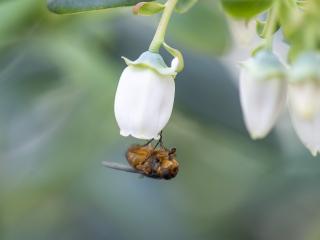Western Australia
August 17, 2020

The native fly Calliphora dubia has shown promise as an effective pollinator of blueberry crops in DPIRD trials as part of a national Managing Flies for Crop Pollination project.
A research project examining the potential for native flies to supplement bees as pollinators of horticulture crops is creating a buzz.
The Department of Primary Industries and Regional Development (DPIRD) is leading the national project funded via Hort Innovation and co-participants from across Australia.
The Western Australian component of the research is examining the performance of native flies as pollinators in avocado orchards and blueberry crops, while the other national partners are examining avocados, mangoes, seed crops and strawberries.
The second year of the native fly trials at DPIRD’s South Perth quarantine glasshouse and in the field at Busselton have proven to be even more successful than the first.

DPIRD research scientist Dr David Cook is examining the performance of native flies as pollinators, as a supplement to bees, in avocado orchards and blueberry crops as part of a national project.
DPIRD research scientist David Cook said while a local south west fly species performed well in blueberry glasshouse trials in 2018, another native species found around Australia produced even better results when tested in 2019.
“While the western golden haired fly Calliphora albifrontalis performed well in 2018, the western blue-bodied fly Calliphora dubia was an even better pollinator, increasing total yields by 36 per cent and berry size by 5 per cent,” Dr Cook said.
“We are now repeating the trial to verify the results and give us more confidence in the findings.
“The next thing to look at is how long the flies remain in the enclosure and examine measures, such as protein lures, to encourage them to linger in the cropping area.”
Insects visiting avocado flowers in orchards north of Perth at Gingin will be monitored this year to determine whether there are any other fly species worth examining as potential additional pollinators to assist bees.
A second year of insect surveys of two avocado orchards near Busselton in 2019 found two species of hoverflies were most prevalent, followed by two species of bibionids or love bugs and the blowfly C. vicina, which is found worldwide.
“The western blue-bodied fly visited avocado flowers around three times more often than the western golden haired fly,” Dr Cook said.
“While fruit production was variable between trees last season, there was still a distinct difference between trees pollinated by the different species, with those pollinated by the western blue-bodied fly producing nearly 50 per cent more fruitlets.”
The trial will be expanded later this year to compare the performance of the western blue-bodied fly, alongside the globally distributed blowfly C. vicina and bees within even bigger tree enclosures at Busselton and a new orchard at Pemberton.
This study will provide an opportunity for two new PhD students from The University of Western Australia and Curtin University to join the project and increase skills and capabilities within the pollination area of the project.
Dr Cook said it would be interesting to see how the western blue-bodied fly performed against the C. vicina, which offered a breeding advantage in the event of commercialisation.
“C.vicina has a long diapause, or period of suspended development during cold conditions, which could be used to help build up numbers when rearing flies for commercial application,” he said.
“This project is looking at the whole package, from identifying suitable native flies for pollination to suitability for commercial rearing.
“It is one thing to have a good pollinator but it’s another to have a fly that can be reproduced on a large, commercial scale.”
Stage two of the project in years four and five will develop rearing techniques for mass production of each species so they can be applied commercially in the horticulture sector.
This work will involve determining what dose of x-ray radiation is needed to render flies that are unable to reproduce, to ensure there is no increase in the natural population.
Other project partners include Western Sydney University, The University of New England, The University of WA, SeedPurity Pty Ltd and Biological Services.
Hort Innovation Research and Development General Manager Alison Anderson said the research would ensure growers were well equipped with an enhanced pollination package to ensure the productivity and sustainability of Australian horticulture.
“The research is progressing really well at a national level, as it continues to develop improved knowledge and offer insights towards a solution,” Dr Anderson said.
“Crop pollination is an international issue, with pressures on bee populations around the globe.
“This research will have far-reaching benefits as we seek to confirm the potential of native flies as an alternate and complementary insect pollinator for commercial horticulture enterprises.”
For more information about this project visit agric.wa.gov.au and search for ‘flies pollination’ or check out the video on the DPIRDWA Facebook page.
The Managing Flies for Crop Pollination project is funded by the Hort Frontiers Pollination Fund, part of the Hort Frontiers strategic partnership initiative developed by Hort Innovation, with co-investment from the Department of Primary Industries and Regional Development, Western Australia, The University of WA, Western Sydney University, University of New England, Seed Purity Pty Ltd and Biological Services and contributions from the Australian Government. It has also been funded by Hort Innovation, using the avocado research and development levy and contributions from the Australian Government. Hort Innovation is the grower-owned, not-for-profit research and development corporation for Australian horticulture.